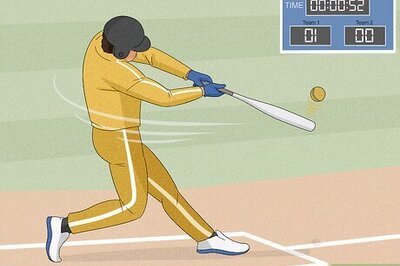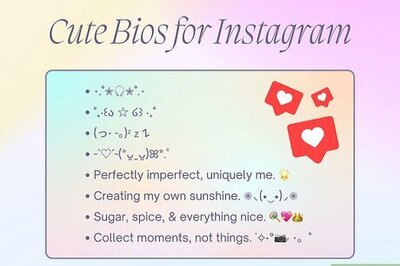
views
What is a reaction in D&D 5e?
A reaction is a special type of action made in response to a trigger. In D&D 5e, combat is structured in terms of the order in which each combatant acts and how many things they can do in each round. A reaction is one such possible combat option—specifically, it’s an instantaneous response that happens when an external trigger (like an enemy moving away or casting a spell) happens. D&D has many different types of reactions, from taking an extra attack to dodging damage from incoming attacks, casting certain spells, or negating effects. All player characters and creatures in-game—including DM-controlled characters and foes—can use reactions. In combat, remember that reactions are optional; when the opportunity to use one arises, you can choose whether or not to do it. Reactions aren’t typically used as often as regular actions and bonus actions in combat, but they can be extremely useful when taken advantage of!
When can you use reactions?
You can take a reaction once per round. The main rule for reactions is that they can occur on your PC’s turn or someone else’s (whether it’s an ally or enemy), depending on the reaction you use. Once you take a reaction, you won’t be able to do so again until the start of your next turn in combat—and if a reaction interrupts another creature’s turn, it can simply complete the turn after the reaction. Since reactions are limited, be judicious about when you use them. You aren’t obligated to take the first reaction that crops up, so figure out what’s worth using and what isn’t. For example, an enemy might move and leave themselves open to an attack of opportunity, but if you need to be able to Counterspell a different enemy, you can choose not to take the attack.
Abilities that cost a reaction often specify what their triggers are. If you’re worried about being able to recognize when you can take a reaction, just look at the specifications for each reaction ability your PC has. Most will tell you what needs to happen before you can use that reaction, whether it’s being attacked, seeing a party member get injured, seeing an enemy move, or something else.
Common Reactions for All Classes
Opportunity attack Every creature in 5e can take opportunity attacks, which are reactions to an enemy fleeing or passing by. Essentially, when a hostile creature moves out of your PC’s reach, you can choose to take an attack of opportunity, making a single melee attack against the creature right before it escapes your reach. For example, say your PC is wielding a dagger and has a reach of 5 feet (which is standard). If a goblin ran by them in combat, passing within 5 feet of your PC, you could take an opportunity attack with your dagger. Opportunity attacks are the most common (and frequent) type of reaction in D&D 5e. It’s a useful way to deal a little extra damage to foes when you get the chance! Attacks of opportunity can be avoided using the Disengage action as well as teleportation spells, all of which effectively allow you to move without provoking enemies.
Readied actions The Ready action allows you to prepare an action and execute it using a reaction before the start of your next turn. It’s useful if you want to wait for something to happen before acting in combat. To ready an action, decide what you want to do and what event will trigger your reaction; when the trigger happens, you can take your reaction after or ignore it. For example, say your turn rolls around in combat, and you want to attack an enemy archmage, but they’ve cast Blink on themselves and temporarily vanished. Instead of spending your action on your turn, you can choose to ready a spell attack and tell the DM that you want to cast it as a reaction once the archmage reappears.
Dismounting Riding mounts (like horses or griffons) isn’t super common among players in 5e, but it’s possible for most PCs—and there’s a reaction associated with it. If your PC is riding a mount in combat and the mount gets knocked prone (meaning it’s knocked off its feet to the ground), you can choose to use a reaction and dismount as it falls to land on your feet. If you don’t use a reaction to jump off a mount that’s falling prone, your PC will also fall prone within 5 feet of the mount.
Popular Reactions for Spellcasters
Counterspell Most spells in 5e cost an action or bonus action to cast—but a few are reactions. One of the most popular (and useful) reactionary spells is Counterspell, which is capable of nullifying another creature’s spell. If the creature’s spell is 3rd level or lower, the spell instantly fails. If the spell is higher-level, you can make an ability check to nullify it (or cast Counterspell at higher levels, if possible). Available for: Sorcerers, wizards, and warlocks Spell type: 3rd level abjuration Counterspell is ideal for blocking powerful spells that can deal a lot of damage to you, or a group of your allies. For example, if an enemy tries to cast Fireball or Cone of Cold, try stopping it with Counterspell. Because spellcasters aren’t typically very good with melee attacks, you probably won’t make many attacks of opportunity with a spellcasting PC. Instead, you’ll use spell reactions!
Hellish Rebuke Hellish Rebuke is another popular reaction spell you can cast as soon as an enemy deals damage to your PC in combat. Upon casting Hellish Rebuke, your target must make a Dexterity saving throw and take 2d10 fire damage on a failed save, or half as much on a success. Available for: Warlocks Spell type: 1st level evocation Hellish Rebuke is especially useful against wounded enemies likely to fall after taking a little more damage; you can use this spell to wipe them off the battlefield! Just remember that spell reactions still use up spell slots (and warlocks have fewer spell slots than most classes), so keep track of your PC’s spell slots each time you use a reaction.
Shield Shield is a simple yet handy reaction spell that grants a +5 bonus to your PC’s armor class (AC) until the start of their next turn, as well as blocking the Magic Missile spell entirely. So, if your PC is injured (or concentrating on a spell) and there’s an incoming attack you really can’t afford to get hit by, you can attempt to block it with the Shield spell. Available for: Sorcerers and wizards Spell type: 1st level abjuration A creature’s armor class represents how difficult they are to successfully attack—so the higher your PC’s AC, the harder it’ll be for enemies to hit them.
Feather Fall You can cast Feather Fall as a reaction on up to 5 falling creatures within range (60 feet). When affected by Feather Fall, a falling creature’s rate of descent slows to 60 feet per round, and they land on their feet without taking damage so long as they land before the spell ends. If someone gets knocked off a cliff or thrown from a tower, Feather Fall is the solution! Available for: Bards, sorcerers, and warlocks Spell type: 1st level transmutation
Silvery Barbs Silvery Barbs is an extremely powerful reaction spell; if a creature within 60 feet succeeds on a d20 roll, you can force them to reroll it (and take the lower result). Then, you can give another creature within range advantage on their next d20 roll within 1 minute. This essentially lets you attempt to tip the outcome of multiple rolls in your favor, all as a reaction! Available for: Bards, sorcerers, and wizards Spell type: 1st level enchantment
Absorb Elements When your PC takes any type of elemental damage (acid, cold, fire, lightning, or thunder), you can use a reaction to cast Absorb Elements. This will reduce the damage your PC takes by half—and if you hit a creature with a melee attack on your next turn, add 1d6 points of that damage type to the attack. Available for: Artificers, druids, rangers, sorcerers, and wizards Spell type: 1st level abjuration
Feats That Interact with Reactions
Certain feats can make your PC’s reactions more effective. If you’re wondering whether there’s any way to empower your opportunity attacks as a martial class (or use them as a spellcaster), the answer is yes. Feats are optional abilities and skills you can give your PC periodically as they level up, and choosing one of the following feats will add bonuses to your opportunity attacks or reactions: War Caster allows you to use your reaction to cast a spell at a creature instead of making an opportunity attack. The spell must have a casting time of 1 action and target only that creature. Sentinel reduces a creature’s speed to 0 after you hit them with an opportunity attack and allows you to take opportunity attacks even if a creature has Disengaged. Finally, if a creature within 5 feet hits a target other than you, you can use a reaction to attack the creature. Polearm Master lets you take opportunity attacks on creatures that enter the reach you have with any polearm weapon (a glaive, halberd, pike, quarterstaff, or spear). Mage Slayer lets you make a melee weapon attack as a reaction against a creature within 5 feet that casts a spell. Fade Away is a feat specific to gnomes; with it, you can use a reaction to become invisible until the end of your next turn after taking damage—or until you attack, deal damage, or force someone to make a saving throw. Uncanny Dodge is a rogue class feature that lets you use a reaction and take half damage on any incoming attack that you can see coming—greatly reducing the damage you take in combat.
Combat Overview for D&D 5e
Combat is organized by a series of rounds and turns. Curious how reactions fit into the grand scheme of 5e combat? Let’s start from the top: combat happens in rounds, each representing about 6 seconds of in-game time. In each round, every combatant gets a single turn, and the order of turns is determined at the beginning of combat by rolling initiative. Once every combatant takes a turn, a new round begins. Surprise. Surprised creatures (creatures that didn’t see their enemies coming) can’t take turns during the first round of combat. Positions. Your DM (dungeon master) will set up the battlefield and figure out where every enemy and PC is placed. Initiative. Rolling initiative means rolling 1d20 and adding your PC’s initiative bonus (Dexterity modifier). Turns are ordered from highest to lowest initiative rolls. Begin turns. After surprise, positioning, and initiative are set in stone, the battle begins, with the combatant who rolled the highest initiative taking their turn first.
Combatants get movement and an action, bonus action, and reaction. Each creature’s turn is broken down into the things they can do: move (a distance up to their movement speed), take 1 action, and take 1 bonus action. This is also where reactions factor in; you can take them on your or any other creature’s turn. Together, these elements form the basics of what you can do in a round! Movement. Every creature has a movement speed that determines how far they can go in a turn. If your PC’s movement speed is 30 feet, that means they can run 30 feet on their turn. Actions. There are standard actions (like Attack, Cast a Spell, Dodge, or Disengage), but most classes offer additional actions with more specific options. Bonus actions. Not every PC will necessarily have bonus actions available—but some of your spells or class abilities (like a bard’s Inspiration or a sorcerer’s Misty Step) cost a bonus action. Regardless, you can use a single bonus action per turn.


















Comments
0 comment